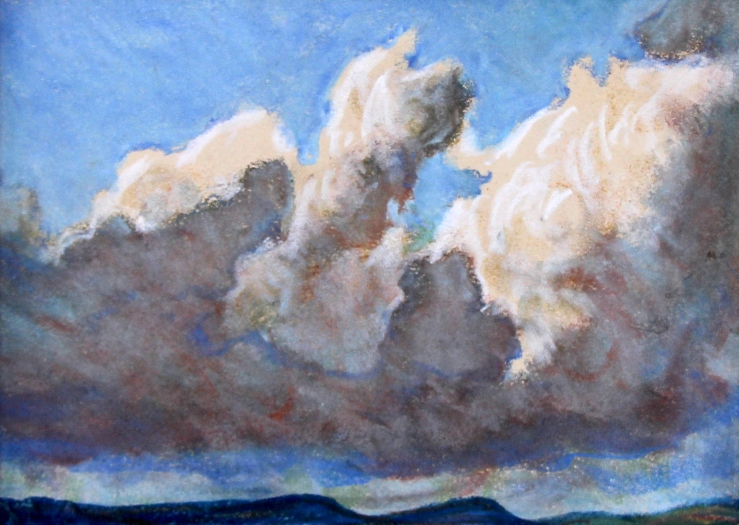There are just a few days left to see WIDENING THE HORIZON: New Mexico Landscapes.
Read on to learn about one of our favorite featured artworks, and make sure to come see it
before the exhibition closes on June 30.
“Travel East to see the real West,” said Charles Lummis to Maynard Dixon. Dixon (1875-1946) was born on a ranch near Fresno, California. His friend and mentor Lummis was a journalist, photographer and poet who walked from Cincinnati to Los Angeles in 1884, a 2,200-mile journey that took him through New Mexico in the dead of winter. Despite the severe hardships of the journey, Lummis fell in love with the Southwest and became a staunch advocate for historic preservation projects and the rights of the Pueblo Indians.
Inspired by Lummis’ tales, Dixon set out on his own Southwestern adventure in 1900. In California, he had studied under tonalist painter Arthur Mathews and worked extensively as an illustrator, but the trip to Arizona and New Mexico swung his artwork in a new direction. He took a horseback ride through the West the following year and developed a heavy impasto style, capturing endless vistas with a vibrant palette. Back in San Francisco, he sold paintings and watercolors dressed in his cowboy uniform: boots, a bolo tie and a black Stetson.
The booming market for illustrations of the Wild West kept Dixon well-fed at the turn of the century. In 1905, he married artist Lillian West Tobey. The following years were wrought with calamity: most of Dixon’s early work was destroyed in the San Francisco earthquake of 1906, and a move to New York in 1907 left Dixon frustrated and uninspired. His return to San Francisco in 1912 ended his first marriage, but renewed his commitment to creating “honest art of the West”, free of the commercialism that influenced his previous work.
In the 1920’s, a new interest in modernism lead Dixon to experiment with post-impressionism and cubism. Dense details gave way to an elegant style. He built a reputation for paintings of spare landscapes dominated by infinite swirling skies. His pastel Love to Babette, a tribute to art patron and San Francisco socialite Babette Clayburgh, is an impeccable example of his mature work.
Dixon married legendary Western photographer Dorothea Lange in 1920, and they had two sons. In late 1931 and early 1932, they lived in Taos, New Mexico in a house owned by their friend Mabel Dodge Luhan. The Taos Society of Artists offered Dixon a coveted spot in their ranks, but he disagreed with their strict bylaws and declined. However, Dixon’s time in New Mexico was perhaps the happiest and most productive of his life. He completed over 40 canvases in his four months there, focusing on the residents of Taos and their complex relationship with the rugged terrain of the High Desert.
During the Great Depression of the 1930’s, Lange made some of her best-known images, documenting rampant poverty in the West. Dixon was in turn inspired to dabble in social realism. The couple was separated for a time when Dixon again took up Western painting in Utah’s Zion National Park and Mount Carmel, and divorced in 1935. Lange lived the rest of her years in Berkeley, while Dixon continued to travel through the West: to Montana, Nevada, Utah, Arizona and New Mexico.
San Francisco muralist Edith Hamlin became Dixon’s third wife in 1937, and they moved to southern Utah in 1939. From their summer home in Mount Carmel, Dixon continued to paint powerful scenes of the West until his death in 1946. His ashes were buried in Mount Carmel.
Learn more about Maynard Dixon on our website, and come see WIDENING THE HORIZON: New Mexico Landscapes now through June 30. Connect with us on Facebook, Twitter and Instagram for daily gallery news.














